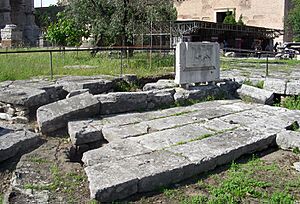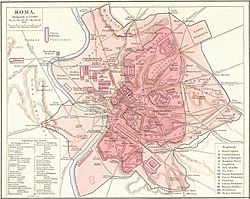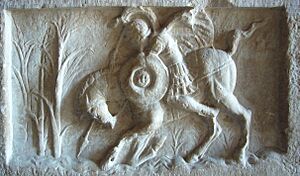Lacus Curtius facts for kids
The Lacus Curtius (say "LAH-koos KUR-tee-us"), which means "Curtius's Lake," was a special spot in the Roman Forum. The Roman Forum was a big public space in ancient Rome. Long ago, this area was probably a marshy lake. Over time, most of it was drained to build the city. But one small part remained wet, forming a basin called the Lacus Curtius.
No one is completely sure why this spot was important in early Roman history. There are many different stories about how it got its name. The name "Curtius" likely comes from the Curtia gens, which was a very old Roman family with Sabine roots. The Sabines were an ancient people who lived near Rome.
Contents
Mysteries of the Lacus Curtius's Name
Even the ancient Romans weren't sure about the true story behind the Lacus Curtius. They had at least three different explanations for its name. Two of these stories were told by a famous Roman historian named Livy. Another story came from a Roman writer named Varro. Let's explore these tales in the order they were said to have happened.
The Sabine Warrior's Swampy Battle
The oldest story about the Lacus Curtius dates back to the 8th century BCE. This tale says the spot was named after a brave Sabine horseman named Mettius Curtius. He was a champion warrior. During a battle, Mettius Curtius supposedly got stuck in the marshy ground. This story makes sense because the area was once a swamp. Also, the Curtia family had Sabine origins, and "Mettius" was a real Sabine name meaning "leader."
The Lightning Strike and the Consul
The second story is from around 445 BCE and is a bit more ordinary. It says that Gaius Curtius Philon, who was a consul (a top Roman official), made the site sacred. He did this after a lightning bolt struck the ground there. Places hit by lightning were often considered special or holy by the Romans.
The Hero Who Saved Rome
The most famous story about the Lacus Curtius is a dramatic myth from about 362 BCE. This is the one Livy thought was most likely. It's a tale that celebrates the Roman nation.
The story goes that a huge crack, or chasm, suddenly opened up in the Roman Forum. The Romans were very worried. An oracle (a person who could see the future) told them they had to throw "that which constituted the greatest strength of the Roman people" into the chasm. If they did, Rome would last forever.
The Romans threw many valuable things into the crack, but nothing happened. Then, a young horseman named Marcus Curtius (who was also from the Curtia family) understood what the oracle meant. He realized that the greatest strength of the Roman people was their virtus, or courage and bravery. So, Marcus Curtius, dressed in his full armor and riding his horse, bravely jumped into the chasm. As soon as he did, the earth closed up, and Rome was saved!
This story is like an epic poem, full of heroism. Some historians think it might be similar to an old Greek story about King Midas.
Other Ideas About the Lacus Curtius
A little to the east of the Lacus Curtius, archaeologists found the bones of a man, woman, and child who had been tied together and drowned. This discovery makes some people wonder if the stories about Mettius and Marcus Curtius are actually old memories of a very ancient ritual. Perhaps people were sacrificed by drowning when the area was still a larger pool. Another idea is that the site was used for punishing people who broke sacred rules, as mentioned in an old inscription nearby called the Lapis Niger.
These ideas are also connected to old Celtic stories from the Middle Ages about lakes suddenly appearing or bursting forth.
Lacus Curtius in Art
The story of Marcus Curtius's brave sacrifice has been a popular subject for artists since the Renaissance. Famous painters like Paolo Veronese and Lucas Cranach the Elder have created artworks showing this dramatic moment.
Related links
- Curtia Gens




